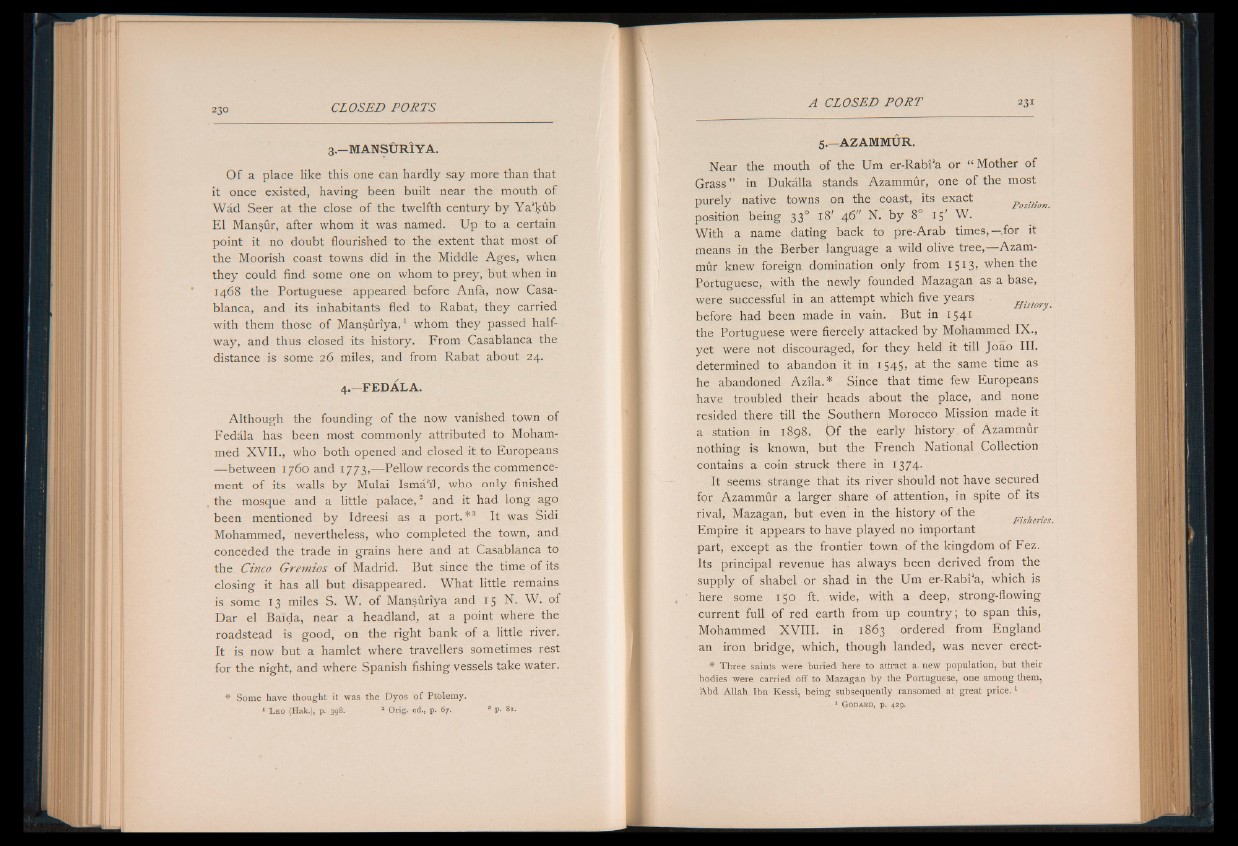
3.—MANSURIYA.
O f a place like this one can hardly say more than that
it once existed, having been built near the mouth of
Wad Seer at the close of the twelfth century by Y a ’kub
El Mansur, after whom it was named. Up to a certain
point it no doubt flourished to the extent that most of
the Moorish coast towns did in the Middle Ages, when
they could find some one on whom to prey, but when in
1468 the Portuguese appeared before Anfa, now Casablanca,
and its inhabitants fled to Rabat, they carried
with them those of Mansuriya,1 whom they passed halfway,
and thus closed its history. From Casablanca the
distance is some 26 miles, and from Rabat about 24.
4.—FEDALA.
Although the founding of the now vanished town of
Fedala has been most commonly attributed to Mohammed
XVII., who both opened and closed it to Europeans
— between 1760 and 1773,— Pellow records the commencement
of its walls by Mulai Isma'il, who only finished
the mosque and a little palace,2 and it had long ago
been mentioned by Idreesi as a port.*3 It was Sidi
Mohammed, nevertheless, who completed the town, and
conceded the trade in grains here and at Casablanca to
the Cinco Gremios of Madrid. But since the time of its
closing it has all but disappeared. What little remains
is some 13 miles S. W. of Mansuriya and 15 N. W. of
Dar el Baida, near a headland, at a point where the
roadstead is good, on the right bank of a little river.
It is now but a hamlet where travellers sometimes rest
for the night, and where Spanish fishing vessels take water.
* Some have thought it was the Dyos of Ptolemy.
» L e o (H ak .), p . 398. s O r ig . ed ., p . 67. * p . 81.
5.—AZAMMUR.
Near the mouth of the Um er-Rabi'a or “ Mother of
Grass” in Dukalla stands Azammur, one of the most
purely native towns on the coast, its exact Position
position being 33° 18' 46" N. by 8° 15' W.
With a name dating back to pre-Arab times,—.for it
means in the Berber language a wild olive tree,— Azammur
knew foreign domination only from x S13> when the
Portuguese, with the newly founded Mazagan as a base,
were successful in an attempt which five years Histor'
before had been made in vain. But in 1541
the Portuguese were fiercely attacked by Mohammed IX.,
yet were not discouraged, for they held it till Joao III.
determined to abandon it in 1545, at the same time as
he abandoned Azila. * Since that time few Europeans
have troubled their heads about the place, and none
resided there till the Southern Morocco Mission made it
a station in 1898. Of the early history of Azammur
nothing is known, but the French National Collection
contains a coin struck there in 1374-
It seems strange that its river should not have secured
for Azammur a larger share of attention, in spite of its
rival, Mazagan, but even in the history of the Fisheries
Empire it appears to have played no important
part, except as the frontier town of the kingdom of Fez.
Its principal revenue has always been derived from the
supply of shabel or shad in the Um er-Rabi'a, which is
here some 150 ft. wide, with a deep, strong-flowing
current full of red earth from up country; to span this,
Mohammed XVIII. in 1863 ordered from England
an iron bridge, which, though landed, was never erect-
Three saints were buried here to attract a- new population, but their
bodies were carried off to Mazagan by the Portuguese, one among them,
Abd Allah Ibn Kessi, being subsequently ransomed at great price.1
1 G o d a r d , p . 429.